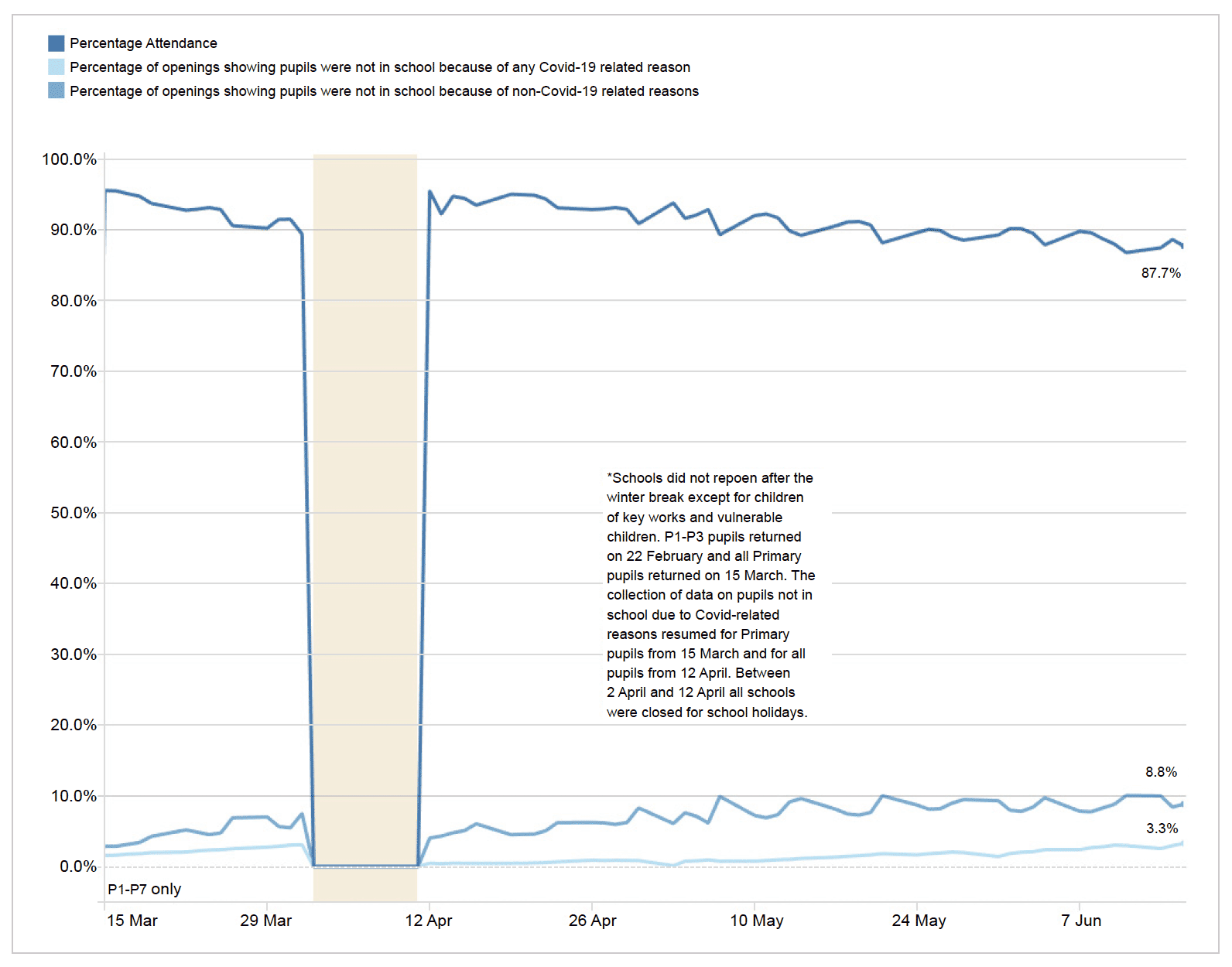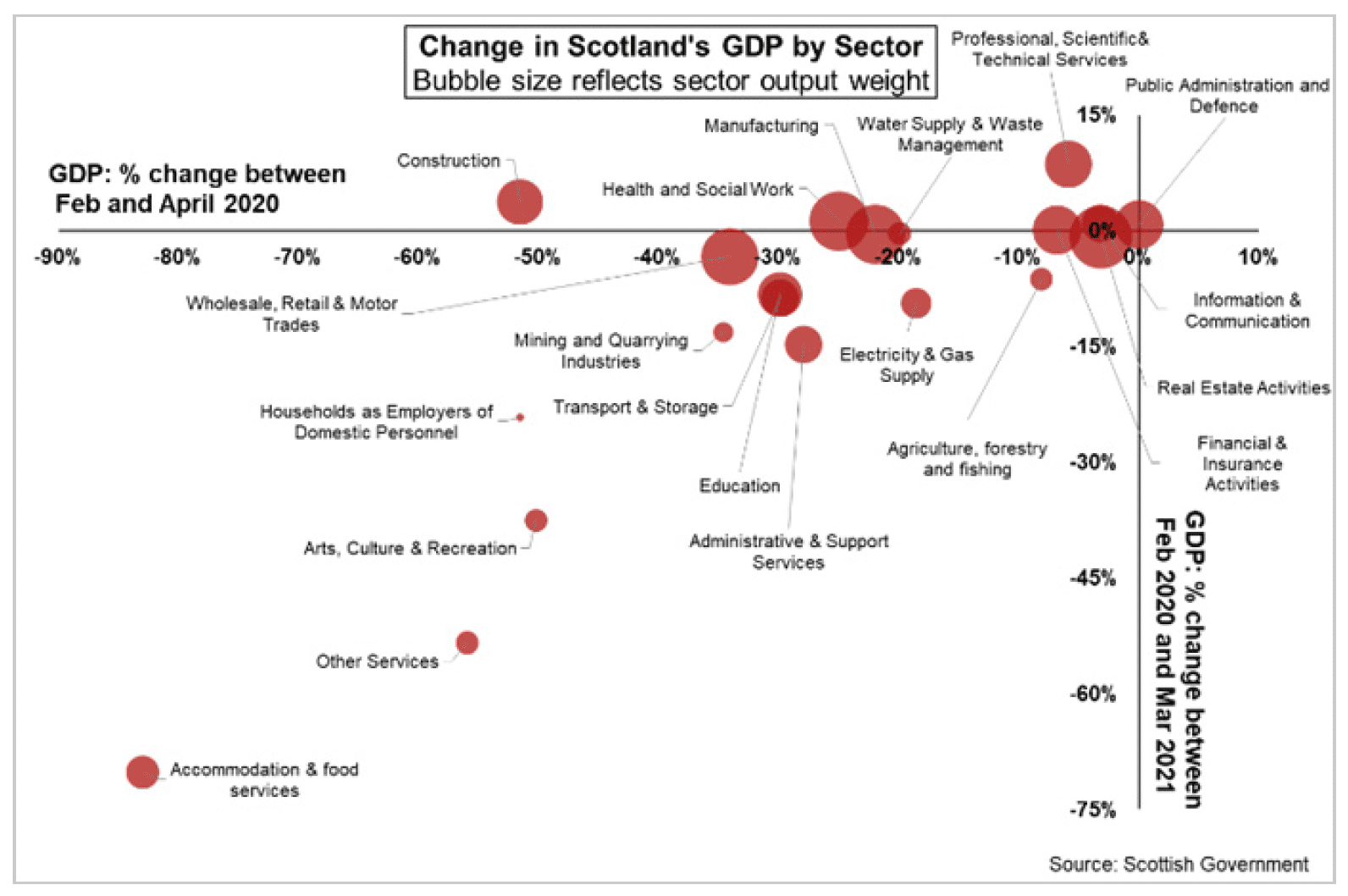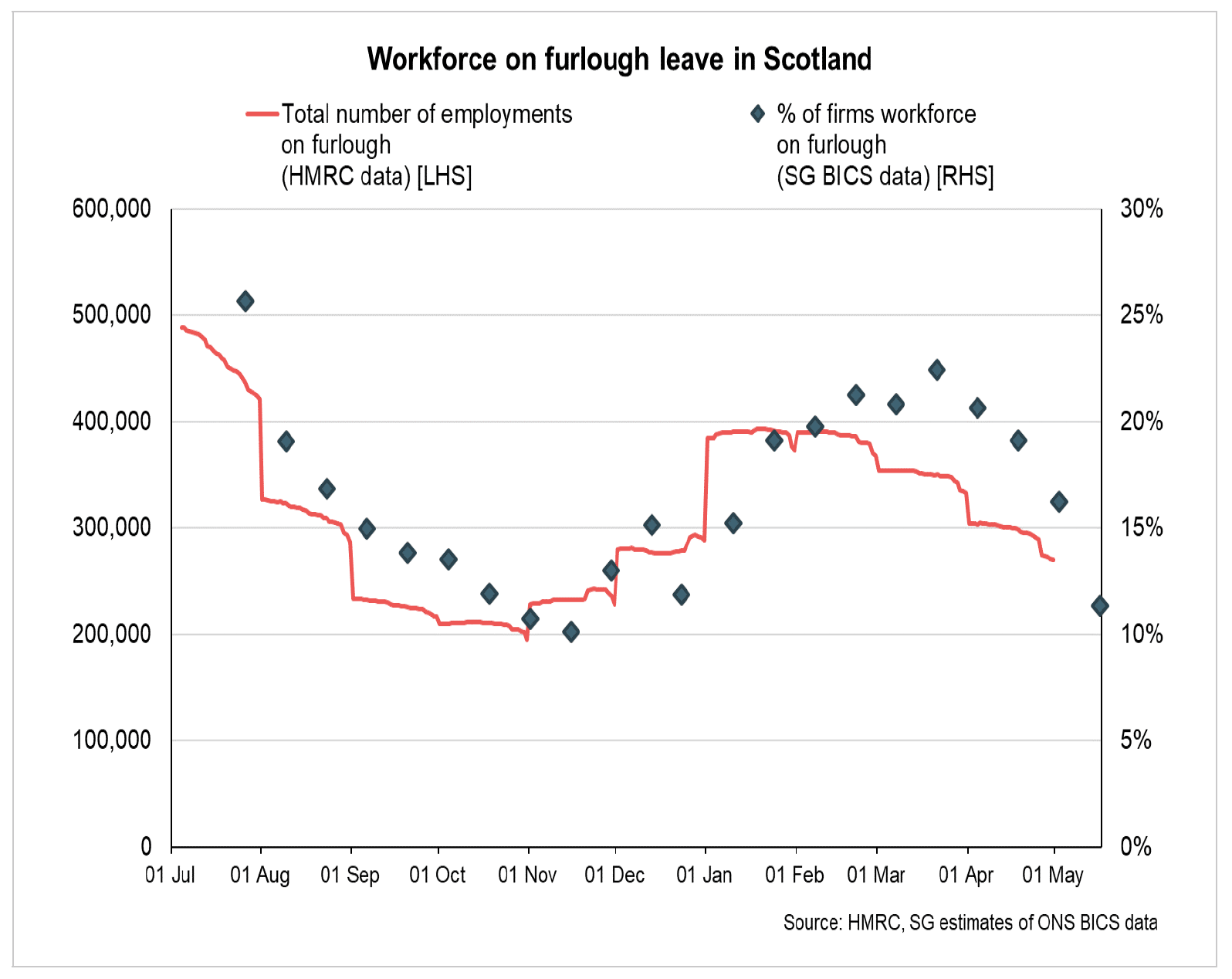Coronavirus (COVID-19): Scotland's Strategic Framework update - June 2021
Sets out how and why our COVID-19 response strategy will change in light of new conditions and what a move beyond Level 0 will look like.
Introduction
As ever with COVID-19, the future trajectory of the epidemic remains uncertain, particularly in relation to new variants. But, increasingly, that uncertainty is being reduced as the promise of the vaccination programme realises its potential.
In early 2021, Scotland was in lockdown and both the economy and people's lives were severely restricted. Vaccinations had commenced and were already helping to protect the most vulnerable but had not begun to reduce transmission of the virus in a significant way.
At the time, the updated Strategic Framework restated our strategic intent: to suppress the virus to the lowest possible level and keep it there, while we strive to return to a more normal life for as many people as possible.[1]
The Levels approach, contained within the Strategic Framework, provided a versatile and proportionate means for managing our path out of lockdown. The graduated levels of protection range from Level 0 (as close to normality as possible while vaccination proceeds) to Level 4 (severe restrictions). The levels continue to enable Scotland to pursue a tailored path towards sustainable recovery, responding to the circumstances in different parts of the county.
As always, our decisions will be cautious and led by data. It remains our hope to progress to something much more like normality over the course of the summer. However, as we have seen throughout the pandemic, nothing is certain. We may see a resurgence of the virus to a level that demands a more severe response to prevent serious illness and deaths. We designed the current strategy with that in mind: we have the ability to apply different levels to respond to new and sometimes unforeseen developments.
Since February, there have been two very significant developments which could influence our future trajectory. One relates to vaccinations and the other relates to the emergence of a new variant of concern of the virus.
Firstly, vaccine uptake has been unprecedented. The latest data is showing 99% uptake in those aged over 50, and over 3.5 million people have now received their first vaccination dose and 2.5 million people have received their second dose. We remain on track to offer every adult in Scotland their first dose of the vaccine by the end of July, supply allowing, and their second dose by mid-September. Having people fully vaccinated is important in reducing risks of morbidity and mortality from COVID-19. Continued successful roll-out and high uptake of vaccination is therefore key in order to try and get ahead of the virus and best protect our continued path out of restrictions and help us to return to a more normal way of living.
The second development is the emergence of the latest Variant of Concern (VOC) – Delta VOC-21APR-02/B.1.617.2 (the 'Delta' varian) – which is highly likely to be significantly more transmissible than the previous VOC-20DEC-01/B.1.1.7 strain (the 'Alpha' variant).[2] The Delta variant has caused an increase in infections, particularly amongst the unvaccinated and partially vaccinated population.
Therefore, whilst the roll-out of the vaccination programme is translating into reduced morbidity and mortality from the virus, it is vital that we continue to exercise caution in light of rising cases of the virus.
The Delta variant is accelerating this strategic challenge: the race between the virus and our vaccines. It is within this context that we are updating our Strategic Framework. This document sets out how and why our COVID-19 response strategy will change in light of new conditions and what a move beyond Level 0 will look like. It also provides an update on how we are using and adapting the six tools set out within our Strategic Framework to suppress the virus:
1. The vaccination programme;
2. The Test and Protect system of testing, contact tracing and self-isolation;
3. Proportionate protective measures (rules and guidance);
4. Measures to manage the risk of importation of the virus;
5. Supporting individuals, businesses and organisations to adhere to protective measures; and
6. Providing care and support to mitigate the harms of the crisis.
Current position
Our response to the pandemic has considered its impact across each of our defined "Four Harms", as well as our continued respect and protection for fundamental human rights. The first of these four harms is the direct harm to people's health. The second is the wider impact on our health and social care services in Scotland and the impacts on non-COVID-19 health harms. The third is the harm to our broader way of living and society, including, for example, the negative effects of increased isolation, particularly for those living alone, and the impact on children's wellbeing from closing schools and childcare settings. The fourth is the harm to our economy, causing deep uncertainty and hardship for many businesses, individuals and households.[3]
The balance of these harms has been shifting during the pandemic, particularly as a result of the vaccination programme. The vaccination rollout has been highly successful to date. As a result, we have seen relatively fewer cases ending in hospitalisation and Intensive Care Unit (ICU) admissions, although the potential for direct harm from COVID-19 remains serious. However, there is likely to come a time where, as the vaccines succeed in reducing serious disease, the other three harms occurring as a result of ongoing restrictions begin to outweigh the direct harm of the virus itself. Consequently, if vaccination is resulting in less serious morbidity and much reduced mortality, it would not be proportionate to continue to impose the same level of restrictions on people's lives.
There remains a degree of uncertainty regarding the impact of the Delta variant on severity of illness, treatment or reinfections. Analysis of vaccine effectiveness against symptomatic disease with the Delta variant suggests that, while vaccine effectiveness is lower in Delta cases compared to Alpha cases after one dose, any difference in vaccine effectiveness after two doses of vaccine is likely to be small.
Following the rise of the Delta variant to dominance in Scotland, the most recent estimate of the R number is between 1.2 and 1.4.[4] This means that case numbers are increasing and we must therefore continue to exercise caution with our approach to easing protective measures.
The spread of the Delta variant in Scotland is both a real threat and a reminder that variants of concern may continue to emerge and threaten to undo the progress we have made so far. With that in mind, it is important to continue to move cautiously in order to reduce the risk of the virus growing out of control among the unvaccinated population.
As noted above, the balance across the four harms has been shifting, in large part due to the success of the vaccination programme. For example, following the publication of Re-mobilise, Recover, Re-design: The Framework for NHS Scotland[5] on 31 May 2020, we are now cautiously and safely beginning to restart as many aspects of our NHS as is possible and we are developing our plans for NHS recovery from the crisis. This is also the case for other aspects of our public services. Further information on our progress in relation to mitigating the societal impacts of the pandemic can be found in the later section on social harms.
Two areas of broader harm – the educational and economic impacts of the pandemic in Scotland – are highlighted below.
Firstly, learning from our experiences in the first lockdown, we purposefully prioritised re-opening school buildings and childcare settings in our route out of lockdown in 2021 – initially to the children of key workers and vulnerable children, then to younger nursery and primary school-age children and some senior phase pupils, and subsequently to all children and young people. The impact of our approach is shown in Figure 1 below, which indicates attendance at schools from 15 March 2021.

Collectively, we must continue to minimise the likelihood of disruption to our children and young people's education after the summer. To do so, we must all continue to play our part in keeping the virus under control, whether by getting vaccinated or by continuing to stick to measures to stop it spreading. Although the overall picture on school attendance above is very much a positive one, the impact of rising case numbers can also be seen on COVID‑19 related absences over recent weeks.
Whilst these absences are still relatively low, and primarily due to self-isolation rather than positive cases, disruption to education is something we are determined to avoid wherever possible. The approach we take to minimising educational harms at the start of the next term will require careful consideration in light of factors such as overall progress on the vaccination programme (including for education staff), a fuller understanding of the impacts of the Delta variant, and our staged approach to the easing of restrictions in wider society. We will continue work over the summer period to develop an approach which will best minimise harms to children and young people, taking into account forthcoming Joint Committee on Vaccination and Immunisation (JCVI) advice on the vaccination of 12 to 17 year olds, and ongoing work to ensure that Test and Protect and self-isolation policy remain aligned with our evolving strategy. In particular, we will consider whether and to what extent the requirement for young people to self-isolate as contacts of positive cases can be significantly reduced in future.
Secondly, COVID-19 has had a very damaging effect on the economy. And although recovery is well underway for many sectors, several sectors that are enduring ongoing restrictions remain particularly badly affected and others are still constrained and unable to operate at full capacity.
Figure 2 shows the impact that the COVID-19 crisis has had on the economy. At its lowest point in April 2020, Scotland's Gross Domestic Product (GDP) fell to 22.6% below its pre-pandemic level in February 2020. By March 2021, GDP had recovered back to 5.4% below its pre-pandemic level (UK: -5.9%).

There were significant differences across sectors in the scale of the initial fall in output in March and April 2020 during national lockdown and in the pace of recovery across sectors since then, which has largely reflected the nature of restrictions over the course of the year.
Manufacturing output fell 22% between February and April 2020. However, in March 2021, manufacturing output had recovered to 0.5% below its pre-pandemic level in February, while construction output fell 51.6% initially and in March had recovered to 3.7% above its pre-pandemic level.
Consumer-facing parts of the services sector have been more directly impacted by restrictions on activity, and particularly during the recent restrictions over the winter months. For example, accommodation and food services output fell 83% between February and April 2020 and following some recovery over summer 2020, and in March, remained 70% below its pre pandemic level. Similarly arts, culture and recreation output in March remained 38% below its pre-pandemic level, having fallen 50% initially between February and April 2020.
The Coronavirus Job Retention Scheme has been supporting the retention of jobs and incomes since March 2020 and is currently set to remain in place until the end of September 2021. Figure 3 shows how the number of jobs supported by the furlough scheme has varied over time as restrictions have changed, gradually increasing from October 2020 as restrictions started to tighten over the winter with 373,000 jobs on furlough at the end of January. At the end of April 2021, there were 269,800 jobs furloughed in Scotland, a rate of 11%. The numbers have been declining since February 2021 as some restrictions have eased. At end of April 2021, the sectors with the highest number of jobs furloughed across Scotland were Accommodation and food services (77,000) and Arts, entertainment and recreation (19,900).

Taking into account the risk that the Delta variant poses and the need for our response to be guided by data not dates, we also recognise the necessity to provide as much clarity as possible to businesses and individuals for the period ahead, particularly as we move beyond Level 0 restrictions. We appreciate that many businesses, particularly in sectors that have been as yet unable to reopen but also in sectors that can open but under ongoing restrictions, need to be able to plan for when they can operate to their full capacity. Recruiting staff and re-establishing supply chains takes time and we will take this into account in our decision-making and communications as far as possible, recognising that improved degrees of certainty will have positive impact on the mental health and well-being of employers and employees.
There is a careful balance that we must strike to ensure that we gain and keep the upper hand against the virus, but also mitigate the damaging consequences that many individuals and businesses have faced as result. Judging this balance has been central to developing our strategic intent as detailed below, and it will remain key in all decisions to come.
Contact
Email: CEU@gov.scot
There is a problem
Thanks for your feedback